
The aroma of freshly baked bread, pastries, and pies is enough to draw anyone into a bakery. Baking has been a staple of culinary traditions in many cultures around the world for centuries. From savory pies to decadent desserts, there’s something about the art of baking that just captures the heart and soul of foodies everywhere.
Baking Basics
Whether you’re a beginner baker or a seasoned pro, understanding the baking basics is essential to creating a perfect baked good. Here are some important elements to keep in mind:
Ingredients
One of the most important aspects of baking is getting your ingredients just right. Each recipe requires a certain amount of flour, sugar, eggs, butter, and other ingredients in order to create the perfect texture and flavor. The right balance of ingredients can make all the difference between a mediocre dessert and an unforgettable culinary masterpiece. Here are some important ingredients and their purposes:
Flour: Flour is the backbone of most baked goods. It provides structure, texture, and flavor. However, all-purpose flour is not always interchangeable with other flours such as cake flour, bread flour, or gluten-free flour. It’s important to use the right type of flour for your recipe as each flour has a different protein level. For instance, cake flour is low in protein, while bread flour is high in protein.
Sugar: Sugar not only adds sweetness to your baked goods, but it also helps retain moisture and provides a golden brown color during baking. There are different types of sugar available, including granulated sugar, brown sugar, confectioners’ sugar, and molasses. Depending on the recipe, you may need to use a specific type of sugar.
Eggs: Eggs are essential in baking as they provide structure, leavening, and moisture. In most cakes and pastries, eggs are used in their entirety, but yolks and whites can also be separated and used in different ways. Yolks add richness and moistness, while whites provide structure and volume.
Butter: Butter adds richness, flavor, and moisture to baked goods. However, using margarine or shortening instead of butter can affect the flavor and texture of your final product. It’s important to use the recommended fat in your recipe.
Leaveners: Leaveners are ingredients that help your baked goods rise. There are three primary types of leaveners: baking powder, baking soda, and yeast. Baking powder and baking soda are both chemical leaveners, while yeast is a natural leavener that requires time to work.
Flavorings: Adding different flavorings such as extracts, spices, or fruits can elevate the taste of your baked goods. However, it’s important not to add too much as it could overpower the other flavors in your recipe.

Like with any recipe, it’s important to read it in full before starting, collect all ingredients in advance to avoid last-minute scrambling for an ingredient and to make sure that the measurements are accurate. By getting the ingredients right, you are setting yourself up for success in baking.
Measuring
Accurate measuring is key when baking. Here are a few tips:
- Use measuring cups and spoons specifically made for baking
- Spoon flour into your measuring cup instead of scooping it directly from the container
- Level off dry ingredients with a straight edge
- Weighing ingredients with a kitchen scale is even more accurate
Mixing
The way you mix your ingredients greatly affects the final outcome of your baked good. Here are some important things to keep in mind:
- Use a light hand when mixing dry ingredients together
- Cream butter and sugar together until light and fluffy for cakes and cookies
- Fold in delicate ingredients like whipped cream or egg whites gently to prevent deflating
- Knead dough gently to develop gluten for bread and pastries
Oven Temperature and Baking Time
Oven temperature and baking time also play an important role in your baked goods. Here are some tips:

- Preheat your oven to the correct temperature before baking
- Use an oven thermometer to make sure your oven is at the right temperature
- Rotate your baked goods halfway through baking to ensure even baking
- Use a timer to keep track of baking time to avoid over or under baking
Baking Techniques
Baking techniques are essential to creating the perfect texture, flavor, and appearance in your baked goods. Whether you’re a beginner or an experienced baker, understanding different techniques is crucial to your success. From mixing methods to kneading and rolling techniques, paying attention to the details can make all the difference between a mediocre baked good and a masterpiece. In this section, we’ll explore a few important techniques that every baker should master. Whether you’re baking a cake, pie, or bread, the right technique can elevate your baked goods to the next level.
Mixing Techniques
Creaming Method: This technique involves creaming together butter and sugar until light and fluffy. This creates air pockets in the mixture which will help your baked goods rise.
Folding Technique: Folding is a delicate technique that involves gently combining ingredients by using a spatula to cut through the mixture and then folding it over itself. This is commonly used when making meringues or soufflés.
Rubbing Method: This method involves rubbing cold butter or margarine into flour with your fingertips until the mixture resembles breadcrumbs. This technique is commonly used in making pastry dough.
Kneading Technique: Kneading is a technique used when making bread or pizza dough. This involves stretching the dough and folding it over itself repeatedly to create gluten strands which gives bread its chewy texture.
Rolling Technique: When making pastry, it’s important to roll the dough gently and evenly to prevent it from tearing or shrinking during baking. If the dough sticks to the rolling pin, dust it with flour to prevent it from sticking.
Baking Tips
Baking is both an art and a science, and every little detail matters when it comes to achieving the perfect result. From preheating your oven to rotating your baking sheet, small tips and tricks can make all the difference in creating bakery-worthy baked goods.
- Preheat your oven before baking to ensure that your baked goods cook evenly and rise properly.
- Use an oven thermometer to ensure that your oven is at the correct temperature.
- Place your baked goods in the center of the oven to ensure even heat distribution.
- Rotate your baking sheet halfway through baking to ensure even browning.
- Remember to cool your baked goods on a wire rack to prevent fogginess.
Creativity Pays Off
One of the best parts of baking is the creativity that comes with it. There are countless recipes out there, but the possibilities are endless. You can add different flavors, spices, and ingredients to create your own unique take on a classic dessert. It’s this creativity that keeps the art of baking alive and inspiring new bakers every day.
Whether you’re following a recipe or experimenting with your own ideas, creativity can lead to delicious results. Here are some ways to harness your creative energy when baking:
Experiment with Flavors
Vanilla, cinnamon, and chocolate are all popular flavors in baking, but don’t be afraid to experiment with other flavors as well. For example, try adding grated orange or lemon zest to your cake batter, or infusing your pastry cream with lavender or earl grey tea.
Mix and Match
Try combining different textures and flavors to create unique desserts. For example, a crunchy cookie crust paired with a smooth cheesecake filling, or a soft cake layered with a tart fruit curd.

Play with Presentation
Presentation is just as important as taste when it comes to baking. Try using cookie cutters to create fun shapes, or piping buttercream into beautiful rosettes. Add edible glitter or gold leaf to give your baked goods a touch of glamour.
Get Creative with Ingredients
Don’t be afraid to deviate from traditional ingredients. For example, use avocado instead of butter to make a healthier frosting, or replace regular flour with almond flour to make a gluten-free cake.
Experiment with Serving Ideas
Instead of serving your dessert on a plate, try presenting it in a unique way. For example, serve cupcakes inside a teacup, or stack your cookies like a tower.
By using your creativity and imagination when baking, you can elevate your desserts to the next level. Don’t be afraid to try new things and experiment with different flavors and techniques. You never know what delicious creations you might come up with.
Baking is both an art and a science, one that requires attention to detail, precision, and creativity. From measuring your ingredients accurately to mastering different techniques, every element of baking is important to creating the perfect outcome. Whether you’re a beginner or an experienced baker, understanding the basics of baking is essential to achieving bakery-worthy results.
So next time you’re in the mood for something sweet or savory, why not try your hand at baking? Channel your inner pastry chef and let your creativity run wild. Whether you’re making a classic apple pie or a modern twist on a chocolate cake, baking is a culinary adventure that can’t be missed.
